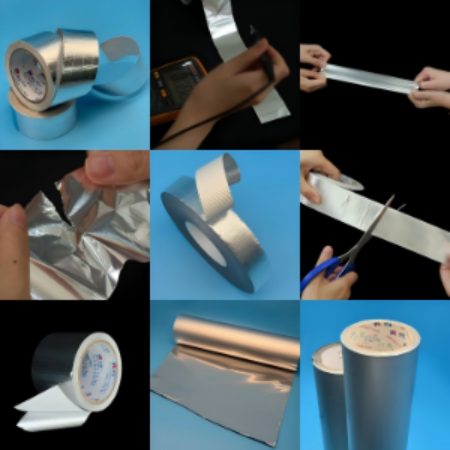In a world teeming with specialized materials and endless adhesive options, one product continues to rise above the noise: aluminum foil tape. But why has this humble adhesive become such a staple in so many industries and households? What makes HVAC foil tape, Industrial Foil Tape, and go-to choices for engineers, contractors, and even DIY enthusiasts?
This deep-dive article will unravel why aluminum foil tape, including popular types like Pure Aluminum Foil Tape Without Liner, Composited Aluminum Foil Tape Without Liner, and Alu Clad, remains an essential component across countless applications.This article will help you understand which foil tape is right for your project and reduce the cost of trial and error.


Aluminum foil tape consists of a thin layer of metal foil combined with an adhesive backing. This seemingly simple configuration belies its immense capabilities—from reflective insulation and electrical shielding to moisture resistance and temperature tolerance. Whether in a data center, duct system, or on a craft table, this tape offers attributes that plastic-based or cloth-backed tapes simply can't.
Variations like HVAC foil tape or Composited Aluminum Foil Tape Without Liner cater to specialized needs—from energy efficiency to easy application in tight spaces.
|
Feature / Tape Type |
Aluminum Foil Tape |
Duct Tape |
|
Heat Resistance |
High (up to 300°F or more) |
Low (adhesive degrades) |
|
Water Resistance |
Excellent (non-porous foil) |
Good, but adhesive weakens with time |
|
Electrical Conductivity |
High (with conductive adhesive tape) |
None |
|
UV/Weather Resistance |
High (especially with acrylic adhesive) |
Low |
|
Typical Applications |
Home appliance manufacturing and repair,HVAC, EMI shielding, insulation, auto repair, roofing |
Temporary repairs, bundling, general fixes |
Aluminum foil’s natural thermal resistance makes it perfect for applications involving high or fluctuating temperatures—such as:
· HVAC sealing and insulation
· Automotive heat shielding
· Appliance manufacturing
Its reflective nature helps conserve or deflect radiant heat, improving both energy efficiency and material protection.
When using conductive adhesive tape formulations, aluminum foil tape becomes a highly reliable material for:
· EMI/RFI shielding in electronics
· Static discharge pathways
· Thermal dissipation in power supplies or LED arrays
From Pure Aluminum Foil Tape Without Liner to reinforced varieties, modern versions adhere to metal, plastic, insulation, and more. Acrylic adhesives offer UV and aging resistance, while rubber-based adhesives provide faster grab for indoor or short-term uses.
The non-porous foil backing makes aluminum foil tape:
· Ideal for outdoor HVAC and construction use
· Resistant to corrosion and mold
· An excellent long-term sealing material in moisture-prone areas
· HVAC Foil Tape: Best for duct sealing, insulation seam closure, and air leak prevention, typically using acrylic adhesive for long-term performance.
· Pure Aluminum Foil Tape Without Liner: Suitable for quick general sealing, wrapping, and patching, with rubber or acrylic adhesive options.
· Composited Aluminum Foil Tape Without Liner: Designed for conforming to irregular surfaces and fast application in tight spaces, often featuring rubber adhesive.
· Industrial Foil Tape: Ideal for heavy-duty sealing, vibration resistance, and insulation, using acrylic or silicone adhesive.
· Alu Clad (Aluminum Composite Laminate Tape): Perfect for long-lasting outdoor insulation and protection against UV and chemicals, with high-performance acrylic adhesive.
1. Home Appliance Manufacturing & Maintenance (Core Application)
Aluminum foil tape is widely used in modern household appliances for sealing, insulation, shielding, and temporary fixing:
Seal refrigeration pipelines in refrigerators and freezers
Thermal shielding for water heaters, microwaves, and ovens
Secure components in washing machines or air conditioners
EMI shielding in kitchen and smart appliances
Positioning and protection during production and assembly
Benefits: Excellent heat resistance, moisture barrier, corrosion protection, strong adhesion to metals and plastics
2. HVAC Systems
Seal duct joints and insulation panels
Improve energy efficiency and block thermal loss
Ideal for outdoor AC units thanks to its weatherproof nature
3. Electronics & Communication
Effective EMI/RFI shielding in electronic equipment
Grounding and signal integrity enhancement
Applied in routers, control panels, and medical devices
4. Automotive & Aerospace
Thermal wraps for engine parts and manifolds
Vibration damping and cable harness protection
Shielding against heat and corrosion
5. Construction & Creative DIY
Emergency repair for metal roofs and gutters
Sealing insulation joints
Used in art pieces, model reinforcement, and light reflectors
· Clean the Surface: Ensure it's free of grease, dust, and moisture.
· Use Proper Tools: Apply firm pressure with a roller to maximize adhesive contact.
· Overlap Joints: At least 1–2 inches to ensure a continuous seal.
· Match Conditions: Use cold-weather foil tape if applying in low temperatures.
Avoid common mistakes like applying to dirty surfaces, using the wrong tape type, or underapplying pressure.
Despite decades of innovation in adhesives, aluminum foil tape still leads in performance, versatility, and reliability. It’s the go-to for anyone seeking:
· Thermal protection
· Electrical conductivity
· Long-term outdoor durability
· Reliable industrial sealing
Choosing a high-quality aluminum foil tape is not only a solution to the problem, but also the beginning of preventing the problem.Whether you're sealing ducts with HVAC foil tape, or finishing off insulation panels using Pure Aluminum Foil Tape Without Liner, you're investing in a solution proven across time, industry, and geography.
So next time you reach for tape, ask yourself—why settle for less when aluminum foil tape can do it all?